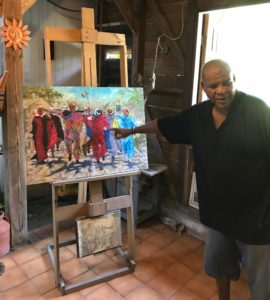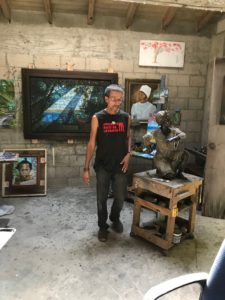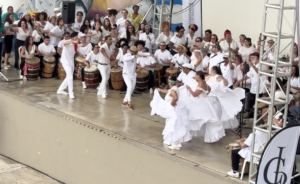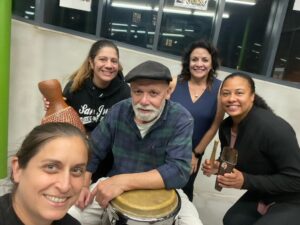Of Taíno Queens and the Legend of Yuiza
by Francisco G. Gómez
Interested in boricua history, especially legends? Here’s a story that’s rather interesting. It’s the legend of Yuiza and her possible connection to the Afro/Taíno people of Loíza. On our first relief assistance trip to Puerto Rico, four months after hurricane María reeked havoc on the island, we had the good fortune to visit the town of Loíza on the northeast coast of the island. We stopped in to say hello to our friends the Ayalas and see how they had managed the storm. The Ayala family is one of the premier exponents of the musical art form known as Bomba.
Marco Ayala, a good friend and supporter of Raíces, quickly arrived after he was contacted by his aunt Rachel and warmly greeted us. Our friends recounted the horrific details of María and her aftermath. We sorrowfully looked upon what was left of the bohio that once housed their Afro Puerto Rican Bomba drums, Vejigante masks and a number of other cultural pieces. We took some pictures together before getting ready to leave for the interior of the island.
Snapping our last pic, Marco asked if we might want to meet Samuel Lind, one of the most famous artists in Puerto Rico, who lives across the road from the Ayalas. Of course we couldn’t pass that up, so we headed for Lind’s house, and by chance he happened to be home and welcomed us in. His entire home is an art studio, each and every room, and there are lots of them! Of the many extraordinary art pieces we had the good fortune to admire, there stood out a painting, that to me, was hauntingly beautiful. The canvas was an image of Yuiza, an interpretation rendered by Lind. You see, there aren’t any written accounts or artifacts to suggest that she ever existed.
I asked Lind to tell us Yuiza’s story, something we knew nothing about. We had no idea that the town of Loiza is named after her, according to Lind. Yuiza/Loíza, sounds similar, doesn’t it? Lind’s account speaks of the Taína cacique, Yuiza, a woman who ruled her tribe of aboriginal people during the Spanish Conquest of Borikén in the 16th century, in and around what was then the Cayrabon River in the Jaymanio region and what is now the Rio Grande de Loíza.
Further research revealed that Yuiza supposedly married a mulatto conquistador, Pedro Mejías and was condemned to death by the other caciques in the area for having conjugal relations with the spaniard. This information would lend credence to the mixture of Taíno and African blood that would account for the largest numbers of Afro-Puertoricans on the island, but again, this is unverifiable.
But, interestingly enough, there are historical records of a 17th century Spanish Crown decree stating that runaway slaves from the British colonies, who were mostly from Nigeria in West Africa, were to be relocated to what is today Loíza Aldea. That could also explain the large numbers of Afro-Puertoricans there.
The image of Yuiza still leaves me in a quandary, and I can’t reconcile whether she is African or Taína, maybe something in between – does it even matter? Perhaps the truth of Yuiza may never be known; however, the words of Tite Curet Alonso ring true when he wrote the famous song “Las caras linda de mi gente negra,” The Beautiful Faces of my Black People! And, this is just one account of several, revolving around the legend of Yuiza…






